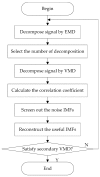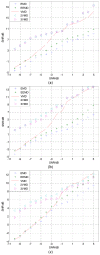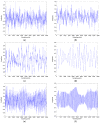Research on Ship-Radiated Noise Denoising Using Secondary Variational Mode Decomposition and Correlation Coefficient
- PMID: 29278380
- PMCID: PMC5795591
- DOI: 10.3390/s18010048
Research on Ship-Radiated Noise Denoising Using Secondary Variational Mode Decomposition and Correlation Coefficient
Abstract
As the sound signal of ships obtained by sensors contains other many significant characteristics of ships and called ship-radiated noise (SN), research into a denoising algorithm and its application has obtained great significance. Using the advantage of variational mode decomposition (VMD) combined with the correlation coefficient for denoising, a hybrid secondary denoising algorithm is proposed using secondary VMD combined with a correlation coefficient (CC). First, different kinds of simulation signals are decomposed into several bandwidth-limited intrinsic mode functions (IMFs) using VMD, where the decomposition number by VMD is equal to the number by empirical mode decomposition (EMD); then, the CCs between the IMFs and the simulation signal are calculated respectively. The noise IMFs are identified by the CC threshold and the rest of the IMFs are reconstructed in order to realize the first denoising process. Finally, secondary denoising of the simulation signal can be accomplished by repeating the above steps of decomposition, screening and reconstruction. The final denoising result is determined according to the CC threshold. The denoising effect is compared under the different signal-to-noise ratio and the time of decomposition by VMD. Experimental results show the validity of the proposed denoising algorithm using secondary VMD (2VMD) combined with CC compared to EMD denoising, ensemble EMD (EEMD) denoising, VMD denoising and cubic VMD (3VMD) denoising, as well as two denoising algorithms presented recently. The proposed denoising algorithm is applied to feature extraction and classification for SN signals, which can effectively improve the recognition rate of different kinds of ships.
Keywords: correlation coefficient (CC); denoising; secondary variational mode decomposition (2VMD); ship-radiated noise (SN); variational mode decomposition (VMD).
Conflict of interest statement
The authors declare no conflict of interest.
Figures















Similar articles
-
Multimode Decomposition and Wavelet Threshold Denoising of Mold Level Based on Mutual Information Entropy.Entropy (Basel). 2019 Feb 21;21(2):202. doi: 10.3390/e21020202. Entropy (Basel). 2019. PMID: 33266917 Free PMC article.
-
MEMS Hydrophone Signal Denoising and Baseline Drift Removal Algorithm Based on Parameter-Optimized Variational Mode Decomposition and Correlation Coefficient.Sensors (Basel). 2019 Oct 24;19(21):4622. doi: 10.3390/s19214622. Sensors (Basel). 2019. PMID: 31652974 Free PMC article.
-
Research on Fault Diagnosis of Gearbox with Improved Variational Mode Decomposition.Sensors (Basel). 2018 Oct 18;18(10):3510. doi: 10.3390/s18103510. Sensors (Basel). 2018. PMID: 30340341 Free PMC article.
-
A Comparative Study of Four Kinds of Adaptive Decomposition Algorithms and Their Applications.Sensors (Basel). 2018 Jul 2;18(7):2120. doi: 10.3390/s18072120. Sensors (Basel). 2018. PMID: 30004429 Free PMC article. Review.
-
A Comparative Analysis of Signal Decomposition Techniques for Structural Health Monitoring on an Experimental Benchmark.Sensors (Basel). 2021 Mar 5;21(5):1825. doi: 10.3390/s21051825. Sensors (Basel). 2021. PMID: 33807884 Free PMC article. Review.
Cited by
-
A new hybrid prediction model of COVID-19 daily new case data.Eng Appl Artif Intell. 2023 Jun 26:106692. doi: 10.1016/j.engappai.2023.106692. Online ahead of print. Eng Appl Artif Intell. 2023. PMID: 38620125 Free PMC article.
-
A Novel Linear Spectrum Frequency Feature Extraction Technique for Warship Radio Noise Based on Complete Ensemble Empirical Mode Decomposition with Adaptive Noise, Duffing Chaotic Oscillator, and Weighted-Permutation Entropy.Entropy (Basel). 2019 May 18;21(5):507. doi: 10.3390/e21050507. Entropy (Basel). 2019. PMID: 33267221 Free PMC article.
-
A novel prediction model based on decomposition-integration and error correction for COVID-19 daily confirmed and death cases.Comput Biol Med. 2023 Apr;156:106674. doi: 10.1016/j.compbiomed.2023.106674. Epub 2023 Feb 21. Comput Biol Med. 2023. PMID: 36871336 Free PMC article.
-
Noise Reduction Method of Underwater Acoustic Signals Based on CEEMDAN, Effort-To-Compress Complexity, Refined Composite Multiscale Dispersion Entropy and Wavelet Threshold Denoising.Entropy (Basel). 2018 Dec 24;21(1):11. doi: 10.3390/e21010011. Entropy (Basel). 2018. PMID: 33266727 Free PMC article.
-
Improved Morphological Filter Based on Variational Mode Decomposition for MEMS Gyroscope De-Noising.Micromachines (Basel). 2018 May 17;9(5):246. doi: 10.3390/mi9050246. Micromachines (Basel). 2018. PMID: 30424179 Free PMC article.
References
-
- Guo X., Shen C., Chen L. Deep Fault Recognizer: An Integrated Model to Denoise and Extract Features for Fault Diagnosis in Rotating Machinery. Appl. Sci. 2017;7:41. doi: 10.3390/app7010041. - DOI
-
- Murguia J.S., Campos C.E. Wavelet analysis of chaotic time series. Rev. Mex. Fis. 2006;52:155–162.
-
- Liu Y.X., Yang G.S., Jia Q. Adaptive Noise Reduction for Chaotic Signals Based on Dual-Lifting Wavelet Transform. Acta Electron. Sin. 2011;39:13–17.
-
- Zhang L., Bao P., Wu X. Multiscale LMMSE-based image denoising with optimal wavelet selection. IEEE Trans. Circuits Syst. Video Technol. 2005;15:469–481. doi: 10.1109/TCSVT.2005.844456. - DOI
LinkOut - more resources
Full Text Sources
Other Literature Sources
Research Materials

